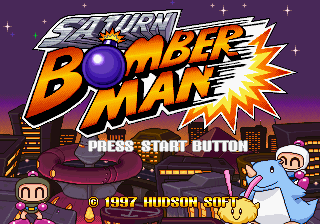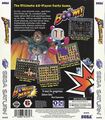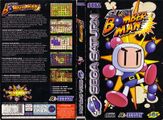Saturn Bomberman
From Sega Retro
| Saturn Bomberman | |||||
|---|---|---|---|---|---|
| System(s): Sega Saturn | |||||
| Publisher: Hudson | |||||
| Developer: Hudson | |||||
| Peripherals supported: Saturn 6 Player Adaptor | |||||
| Genre: Action | |||||
| Number of players: 1-10 | |||||
| |||||
Saturn Bomberman (サターンボンバーマン) is a 2D action video game developed and published by Hudson exclusively for the Sega Saturn console. It is part of the Bomberman series of games.
As well as offering a single-player campaign, Saturn Bomberman is notable for its multiplayer options, allowing up to 10 human players to compete on-screen through the with the use of the Saturn 6 Player Adaptor (and in Japan, Hudson made its own Bomberman-themed one). Even today some modern iterations of Bomberman lack this feature. Online play can be found in the the US and Japanese versions of the game, though the European version does not support this feature.
It is also the only Bomberman game on the Saturn to be released outside of Japan. Other releases for the console include Saturn Bomberman Fight!! (a largely unrelated game) and Bomberman Wars (a tactical RPG).
Contents
Gameplay
Saturn Bomberman is divided into three modes of play, though each mode plays in the traditional Bomberman fashion. The game is played on a grid where the player drops bombs and must defeat opposing foes and clear obstructions. Power-ups are distributed to enhances the character or increase the reach of dropped bombs or it's behavior. These rules are universal to the game modes below.
Normal Game
Normal Game is the story mode for Saturn Bomberman and supports up to two players. Players take control of White and Black Bomberman and must play through a series of levels based around different time periods.
The main antagonists are the Hige Hige bandits, who have gone on to be featured in other Bomberman titles and animated series including Bomberman Generation, Bomberman Jetters and more.
Battle Game
Battle Game serves as the multiplayer mode that goes up to 10 players through the use of two Saturn 6 Player Adaptors. You can also set up a series mode that allows specifications such as how many players playing, which stages are played and the rule set. In the US and Japanese versions of the game, players can make use of the Sega NetLink modem and link up one other system with up to 2 players per console for up to 4 player multiplayer online.
Depending on how many players are allowed to play determines which stages can be selected. Up to 8 players can choose from any of the gimmick stages. 10 player matches can only be played on the Wide Stage. This stage appears zoomed out to accommodate for the additional players and does not feature any gimmicks.
Instead of using differently colored Bomberman, players can choose from White and Black Bomberman as well as a host of other Hudson Soft based characters and mascots. This includes Hudson Soft's mascots Kotetsu and Miss Honey, Bonk from the P.C. Kid/Bonk series, Master Higgins from the Adventure Island games, Milon from Milon's Secret Castle, Manjimaru from the Neutopia series and Kabuki and Kine from the Tengai Makyou series. There are also two secret characters including a bear named Manto and Yuna from the anime series Galaxy Frauline Yuna.
When playing online, players are split between two teams with up to two players each. Red Team plays with White Bomberman and Miss Honey. Blue Team plays with Black Bomberman and Kotetsu. If one team has two human players and the other only has one, the remaining slot will be replaced by a computer controlled teammate. Maps are selected at random.
Stages
- Stage 1 - Path to Glory
- Stage 3 - Jungle Trap
- Stage 4 - Desert Twister
- Stage 5 - Space Colony
- Stage 6 - Bouncing Bomber
- Wide Stage - Can only be played if "Wide" is selected in the rules setup. This is the only map that will fit up to 10 players.
Master Game
Master Game is similar to Normal Game that supports one player only. Players play as White Bomberman and go through twenty rooms. At the end of the game, players are graded based on their performance.
Items
The game features a number of items that are split across all three game modes. While most will provide players benefits, some items may also hinder them. A letter next to each one notes where the item can be found. N refers to Normal Game, B refers to Battle Game and M refers to Master Game.
| Bomb | N, B, M |
| Fire | N, B, M |
| Speed | N, B, M |
| Sandals | N, B, M |
| Penetrator | N |
| 1-Up | N |
| Bomb Kick | N, B, M |
| Power Glove | N, B, M |
| Bomb Pass | N |
| Block | N |
| Remote Control | N, M |
| Power Bomb | N, B |
| Bead Bomb | N, B |
| Line Bomb | N, B |
| Fire Suit | N, M |
| Heart | N, B, M |
| Rubber Bomb | N, B |
| Mine | B |
| Clock | N |
| Merger | B |
| Apple | N, B, M |
| Meat | N |
| Ice Cream | N, M |
| Egg | N, B |
| Skull | B |
| Devil | B |
Saving Data
Saturn Bomberman makes use of the Saturn's internal battery back-up as well as the Saturn Backup Memory to save data for all three modes.
| Name | Comment | File Size |
|---|---|---|
| BOMBERSS_## | NORMAL | 1 |
| BOMBERSS_## | BATTLE | 11 |
| BOMBERSS_## | MASTER | 5 |
Physical Scans
| 83 | |
|---|---|
| Based on 41 reviews | |
| Saturn, JP |
|---|
50x50px Disc |
| Saturn, JP (Satakore) |
|---|
| Bomberman games for Sega systems | |
|---|---|
| Bomberman Special (198x) | |
| Mega Bomberman (1994) | Mega Bomberman: Special 8 Player Demo (unreleased) | |
| Saturn Bomberman (XBAND) (1996) | Saturn Bomberman Fight!! (1997) | Bomberman Wars (1998) | |
| Bomberman Online (2001) | |
- ↑ Computer & Video Games, "October 1996" (UK; 1996-09-09), page 78
- ↑ Computer & Video Games, "May 1997" (UK; 1997-04-11), page 72
- ↑ Edge, "October 1996" (UK; 1996-08-30), page 89
- ↑ Electronic Gaming Monthly, "November 1997" (US; 1997-1x-xx), page 193
- ↑ Famitsu, "1996-07-26" (JP; 1996-07-12), page 1
- ↑ Fun Generation, "09/96" (DE; 1996-08-14), page 82
- ↑ Fun Generation, "07/97" (DE; 1997-06-12), page 92
- ↑ Gambler, "7/1997" (PL; 1997-xx-xx), page 1
- ↑ GameFan, "Volume 4, Issue 10: October 1996" (US; 1996-xx-xx), page 21
- ↑ Game Power, "Luigio 1997" (IT; 1997-0x-xx), page 38
- ↑ GamePro, "October 1997" (US; 1997-xx-xx), page 148
- ↑ Game Informer, "October 1996" (US; 1996-xx-xx), page 58
- ↑ Game Informer, "October 1997" (US; 1997-xx-xx), page 66
- ↑ Gry Komputerowe, "7-8/1997" (PL; 1997-xx-xx), page 1
- ↑ Hobby Consolas, "Mayo 1997" (ES; 1997-xx-xx), page 78
- ↑ Intelligent Gamer, "October 1996" (US; 1996-xx-xx), page 66
- ↑ Joypad, "Septembre 1996" (FR; 1996-0x-xx), page 69
- ↑ MAN!AC, "09/96" (DE; 1996-08-14), page 53
- ↑ MAN!AC, "05/97" (DE; 1997-04-09), page 81
- ↑ Mega Fun, "09/96" (DE; 1996-08-21), page 76
- ↑ Mega Fun, "05/97" (DE; 1997-04-02), page 82
- ↑ Mean Machines Sega, "November 1996" (UK; 1996-10-04), page 80
- ↑ Next Generation, "November 1996" (US; 1996-10-22), page 273
- ↑ Next Generation, "November 1997" (US; 1997-10-21), page 201
- ↑ Player One, "Mai 1997" (FR; 1997-xx-xx), page 86
- ↑ Playmag, "Mai 1997" (FR; 1997-0x-xx), page 84
- ↑ Saturn Fan, "1996 No. 17" (JP; 1996-08-02), page 186
- ↑ Saturn Fan, "1996 No. 19" (JP; 1996-09-06), page 80
- ↑ Saturn+, "Issue 4" (UK; 1996-10-24), page 31
- ↑ Saturn Power, "June 1997" (UK; 1997-xx-xx), page 75
- ↑ Secret Service, "Lipiec/Sierpień 1997" (PL; 1997-xx-xx), page 66
- ↑ Sega Magazin, "Juni 1997" (DE; 1997-05-14), page 68
- ↑ Sega Power, "October 1996" (UK; 1996-08-29), page 46
- ↑ Świat Gier Komputerowych, "6/1997" (PL; 1997-xx-xx), page 1
- ↑ Sega Saturn Magazine, "May 1997" (UK; 1997-04-12), page 52
- ↑ Sega Saturn Magazine, "1996-12 (1996-07-26)" (JP; 1996-07-12), page 220
- ↑ Sega Saturn Magazine, "Readers rating final data" (JP; 2000-03), page 13
- ↑ Sonic the Comic, "8 July 1997" (UK; 1997-06-25), page 15
- ↑ Super Power, "7 1997" (FI; 1997-0x-xx), page 50
- ↑ Ultra Game Players, "October 1997" (US; 1997-09-16), page 90
- ↑ Video Games, "9/96" (DE; 1996-08-28), page 91











